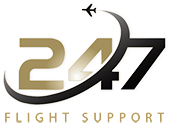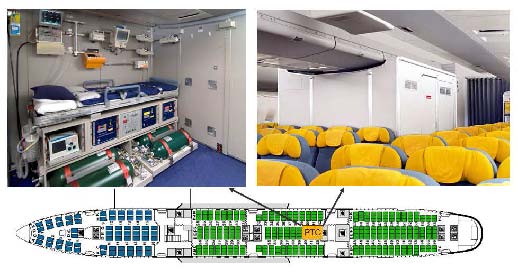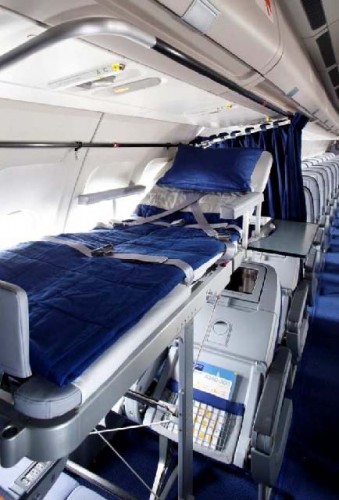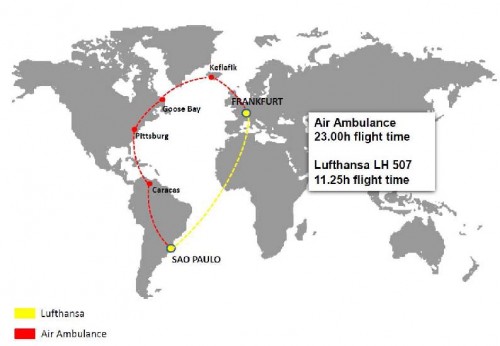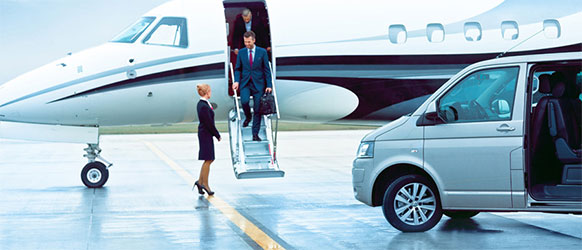HOW LUFTHANSA CARES FOR PASSENGERS’ MEDICAL NEEDS
Boeing 737 Manufactured in 3 Mins Must Watch
28/02/2016Emirates completes world’s longest nonstop flight
06/03/2016Lets face it, nobody wants to need medical care while on board a plane. And yet, with a huge number of people traveling by air everyday, it’s inevitable that it will happen with some regularity. In fact if you travel by air regularly, you have probably heard the flight attendants ask over the PA if there is a “medical professional onboard.”
Any malady that can occur on the ground can happen in the air, and the altitude while on a commercial aircraft can even exacerbate certain medical conditions. That means that some people may be more likely to need medical assistance in the air than they do on the ground.
For German airline Lufthansa, there are about 3,000 passenger medical emergencies that occur on board each year. Of those, an average of 54 emergencies are serious enough that they require the flight to be diverted so that a patient can obtain urgent medical care. I recently had a chance to sit down with the airline and learn how they cope with these situations. Not only is the airline well prepared for any emergency that may arise in flight, they are also ready to treat those who need care before they board the aircraft.
Emergencies On Board
As mentioned above, Lufthansa averages 3,000 on-board medical emergencies of varying levels of severity each year. Just like any other airline, their flight attendants receive regular training on inflight first aid and emergency procedures. Crews are also trained to assist medical professionals when that need arises. However, this is where the similarities between Lufthansa and most other airlines ends.
On a Lufthansa flight, making a public call for any medical professionals on the plane is a last resort. The airline prefers to be far more discreet. After all, does the whole plane always need to know that somebody on board is having a problem? To accomplish this, Lufthansa launched the Doctors on Board program for physicians.
Doctors on Board allows Lufthansa to identify doctors long before an emergency occurs. By doing this, the cabin crews can personally and discreetly summon the doctor if their skills are needed during a flight. In order to find doctors who could potentially participate in this program, the airline scoured the data from its Miles and More frequent flier program. By doing this, Lufthansa was able to identify 15,000 doctors who regularly fly the airline. Of those, 10,000 opted to join the program.
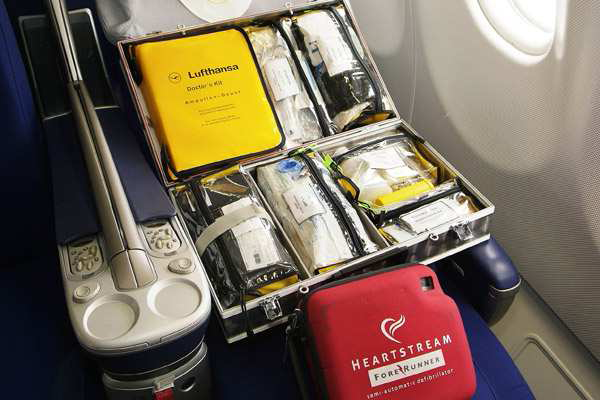
The “doctor kit” of medical supplies and drugs. One is stocked on every Lufthansa aircraft. Photo: Lufthansa
Participation in the Doctors on Board program carries with it several benefits. The doctors are issued a handbook about aviation medicine, as well as receiving news and information via both the internet and postal mailings. They are insured by Lufthansa for any care that they provide during a flight. They are also rewarded with 5,000 Miles and More award miles and a discount code for €50 off of their next flight, plus they receive a special bag tag identifying their participation in the program. Finally, they are given the opportunity to participate in a course on aviation medicine and on-board emergency handling, for which they are paid an additional fee.
In the event that their services are needed inflight, Lufthansa stocks each aircraft with an extensive doctor’s kit. These kits are filled with high-quality medical equipment and a large selection of drugs and medications that may be needed in case of an emergency. These kits are separate from the first aid kits that the cabin crew has access to. And all of the costs of providing emergency medical care onboard are borne by the airline.
Transporting Ill Passengers
Of course, not every passenger who needs to travel by air is in perfect flying condition. There are a variety of medical situations in which a person may be able to fly with certain accommodations. Perhaps the most basic of these is the need for a little extra room. If one seat isn’t quite enough space for a person with a medical condition, Lufthansa can provide an empty seat next to them for a fee on all flights. Another option on long-haul flights is a full lie-flat seat in First or Business class, providing both space and comfort to the passenger.
As a result of the thinner air that comes from a cabin altitude of roughly 8,000 feet, some passengers with reduced lung function need supplemental oxygen while onboard. Lufthansa has specialized Wenoll System oxygen supplies available for use on all flights. These devices provide up to 15 hours worth of supplemental oxygen for passengers in need.
For those passengers that must remain lying down for the entire flight, there is the option of stretcher transportation. On each Lufthansa aircraft, a section of seats at the rear of the Economy cabin can be folded forward, providing space for a specialized stretcher to be installed. These stretchers cover several rows and require the width of two economy seats. Due to emergency egress requirements, the stretcher must be positioned along the side of the aircraft. For patient privacy, a curtain is installed around the stretcher.
A caretaker travels with each stretcher patient. On aircraft where the Economy cabin has rows of two seats along the side of the plane, that caretaker would sit across the aisle from the patient being transported. For aircraft that have three seats between the aisle and the window, including all narrow-body aircraft, the attendant would sit in one of the aisle seats next to the stretcher.
Lufthansa can accommodate requests for stretcher space with 24 hours of advance notice. These requests are made through the airline’s Medical Operations Center. This dedicated team is responsible for all of the necessary arrangements that are needed in order to transport a patient. In addition to managing the operational logistics, this team also ensures that the patient is medically cleared for travel. Because of the limitations in treating a patient being transported in this manner, they must be in a relatively stable condition in order to fly. After all, diverting a flight is expensive and can be a major inconvenience to the other passengers.
The Flying ICU
Sometimes, however, waiting for a patient to stabilize before transporting them just isn’t an option. In certain cases, the best option for a patient’s recovery is to evacuate them to a country where better medical care is available. Typically, that evacuation takes place on a small air ambulance jet that has been specially equipped for this mission. However there are a few significant drawbacks to this method. First, it is incredibly expensive. Costs for a long-haul air ambulance flight can easily exceed €100,000 ($125,000). And the flights can be extremely long. The relatively short range of the jets that are used mean that they need to make multiple fuel stops en route, which has the potential to significantly increase the distance that needs to be flown. This, in turn, increases the flight time significantly.
However, Lufthansa has another option available for some of these patients. The airline has developed the Patient Transport Compartment, a “flying ICU” of sorts, that allows unstable patients to be transported in a method that is both faster and more economical than an air ambulance jet. This compartment is suitable for the transport of just about any critical care patient. The only notable exception are those patients who are being treated for communicable diseases, including the recent Ebola outbreak in Africa. The compartment was designed by Lufthansa’s medical department, and is built and sold by Lufthansa Technik.
The Patient Transport Compartment is a fully-enclosed hospital room in the sky that can be installed center section of seats on some of the airline’s A330, A340, and 747-400 aircraft. A version that can be used Lufthansa’s 747-8i and A380 fleets is coming this winter. The compartment is installed as needed. Several rows of economy class seats in the center section at the rear of the plane are removed. Next, walls are installed along with several modules of medical equipment. In addition to the patient’s bed, the compartment also has seats for a doctor and a paramedic. As an added feature, family members of the patient can travel on the same aircraft, something which is not possible on a conventional air ambulance.
Each aircraft that is capable of having this compartment installed must be specially modified in advance of the compartment being loaded. As a result of the added installation costs and the weight that must be carried whether a patient is being transported or not, only a few of each compatible fleet type are given the modifications. One of the modifications that must be made is the installation of a dedicated outflow line. This is a regulatory requirement that exists because of the use of large quantities of bottled oxygen and other gases. Another necessary modification, required on the A380s that will be able to be fitted with the Patient Transport Compartment, is reinforcement of the floor in the rear of the aircraft.
The core of the Patient Transport Compartment is the bed module. It is equipped with several large bottles of oxygen, as well as the most essential pieces of equipment for monitoring and treating patients. Other medical equipment is installed elsewhere in the compartment. This gear includes telemetry monitors, ventilators, injection and infusion pumps, a defibrillator, blood gas analysis equipment, and a suction machine.
The Patient Transport Compartment reduces the cost of transporting a critical patient to between €32,000 ($40,600) and €68,000 ($86,400). This is pretty much an all-inclusive price that includes more than just the costs of transporting the patient and the installation and removal of the compartment. All medical equipment and supplies that are needed are provided by Lufthansa. The airline also sends a paramedic who has been trained in the use of the compartment to assist in the patient’s care. The cost even includes business-class transportation of the patient’s doctor to the patient, so that they may accompany the patient back to Germany while providing care. The doctor’s services to the patient are just about the only thing that isn’t included in the price. And Lufthansa allows one relative to accompany the patient at no additional charge.
While Lufthansa is the only airline currently flying the Patient Transport Compartment, that doesn’t mean that they are the only customers of the equipment. Lufthansa Technik has found customers for the core module in the Luftwaffe and United States Air Force. And the Patient Transport Compartment is a popular option for the private jets of Middle Eastern sheiks. The airline is currently exploring offering the Patient Transport Compartment onboard other Lufthansa Group carriers such as Swiss Airlines and Brussels Airlines, as new fleet types such as the A350 are introduced.
Lufthansa’s patient transportation services are something that is relatively unique, especially among European airlines. It enables the airline to respond as necessary whether an emergency effects one patient or many. In fact, the largest use of the airline’s patient transportation service was following the Asian tsunami in 2004. As for the most common use of the Patient Transport Compartment, Lufthansa told me that it was carrying German citizens injured in motorcycle crashes in Bangkok back to Germany for treatment.
